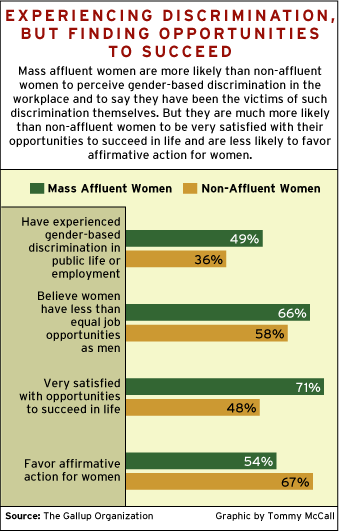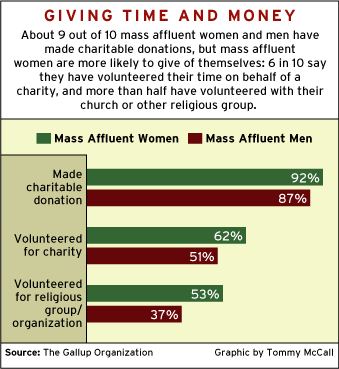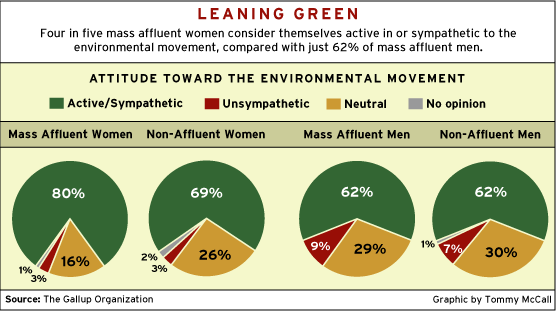In 1980, 15% of U.S. households had annual incomes of more than $75,000 (in 2003 adjusted dollars). Today, that figure is up to 26%, reports the Census Bureau. This means that one in every four households in the country now belong to the ranks of the mass affluent.
Smart marketers have been paying close attention to this growing and substantial demographic group, which was spawned in the 1980s -- a period of rising inequality, according to the census. Educated, idiosyncratic, and flush with discretionary income, the mass affluent defy easy characterization, according to Â鶹´«Ă˝AV Poll data. This series of articles explores the complex characteristics of the mass affluent and offers insights into how to market to them. This article discusses mass affluent women.
Fifty years ago, Birds Eye frozen food and Campbell's soup vied for the female consumer's attention, and she was typecast as a homemaker who sought low-ticket goods. Today, in her avatar as superconsumer, she should not be taken for granted by marketers. Yet many businesses are just now becoming aware of the size and potential of this increasingly important market.
 |
By some estimates, women control about $5 trillion in U.S. business and consumer spending. It has been widely noted that women influence some 80% of all consumer spending in the United States; 94% of home furnishing purchases are made by women or are influenced by their opinions. And women's influence extends to a slew of other product categories, including homes (91%), new bank accounts (89%), do-it-yourself products (80%), and automobiles (60%), according to Marketing to Women: How to Understand, Reach, and Increase Your Share of the World's Largest Market Segment by Martha Barletta.
Generational changes in women's education, pay, representation in the workforce, and domestic roles are what brought women to this point, and those factors practically guarantee that women as superconsumers are here to stay.
One key subset of women who have proportionally more discretionary income is the mass affluent. Living in households that earn more than $75,000 a year, they represent about one quarter of all women nationwide, or about 15% of the general public.
She's no Murphy Brown
When thinking of mass affluent women, forget dated stereotypes of the idle rich. Even the original Murphy Brown character -- a single career woman with no children -- represents just 7% of all affluent women. Most of these women -- 75% -- juggle a number of responsibilities, whether it is work and marriage; marriage and children (under 18 years of age); children and work; or work, marriage, and children. In contrast, only 43% of non-affluent women play these multiple roles.
The clear majority of affluent women are less than 50 years old, while a slight majority of non-affluent women are 50 or older. As a result, affluent women are more likely to be in the parenting stage of life: 45% have children under 18, versus 36% of non-affluent women. And they are more likely to be in the workforce: 67% vs. 50%. It's clear these women are busy.
They're more stressed than affluent men . . .
Affluent women say they experience more daily stress than do affluent men; the same gender stress gap is seen among non-affluents. Women are just more likely than men to perceive (or to admit) stress in their lives. Still, this is an important fact to know when segmenting the affluent women market.
Forty-two percent of affluent women report that they are frequently stressed, compared to 32% of affluent men who say the same. Overall, 89% of affluent women report at least occasional stress, vs. 77% of affluent men.
Little wonder, then, that the U.S. mass-market day-spa category is booming -- the number of such spas doubled over the last five years to about 8,700 today -- or that for $32.95, women can buy a product called "Dr. Hauschka Stress Less Honey."
Although most affluent women are employed, and a relatively large proportion are also working mothers, they are no more likely than non-affluent women to be frequently stressed. Maybe the effects of a newly democratized luxury like a neighborhood day spa are kicking in, or perhaps affluent women lack the additional stresses imposed by tight finances, but it all seems to net out in the wash.
. . . yet they're happy, healthy, and feel good about their lives
Most pollsters will tell you that surveys reveal that women are greater worriers than men, perhaps because women are just more comfortable with revealing their anxieties. Whatever the case, this pattern holds true when comparing the responses of affluent women to those of affluent men. Affluent women are especially worried about the availability of affordable healthcare. They also fret more about crime and violence, the quality of the environment, hunger and homelessness, and unemployment.
Despite all their worrying, affluent women experience higher levels of subjective well-being. Researchers have found that beyond the $35,000 annual income threshold, money doesn't usually inspire higher levels of "happiness." Affluent women, however, seem to be an exception to this: Nearly two-thirds of affluent women (66%) describe themselves as "very happy," compared with 57% of affluent men and 48% of non-affluent women. (See "Are You Happy Now?" in See Also.)
The self-reported physical and mental health of affluent women is also quite good -- similar to affluent men, but much better than non-affluents. Affluents consider themselves both physically and mentally healthy, and poor health provides little disruption in their lives.
Interestingly, affluent women are somewhat more likely than non-affluent women to perceive gender-based discrimination in the workplace and to say they have been the victims of such discrimination themselves. Yet they are much more likely than non-affluent women to be very satisfied with the opportunities they have had to succeed in life and are less likely to favor affirmative action programs for women. These are women who have gotten ahead, and perhaps as a result, they have an overarching feeling of satisfaction about their lives. (See graphic "Experiencing Discrimination, But Finding Opportunities to Succeed.")
Status conscious
Affluent women tend to have higher perceptions of their social status than do affluent men. While 33% of affluent men say that they belong to the upper-middle class, 50% of all affluent women put themselves in this category.
The important question for marketers is: Are affluent women really members of the "upper-middle class," or do they just aspire to membership? And if affluent women have more determined aspirations for an upper-class lifestyle, it could well be that women are driving the mass-prestige, or "masstige," phenomenon more than men are.
Some of the most publicized masstige offerings have been in women's fashion -- and so Isaac Mizrahi, Oscar de la Renta, and Karl Lagerfeld no longer cater exclusively to the ĂĽber-rich. In Wear More Cashmere: 151 Luxurious Ways to Pamper Your Inner Princess, author Jennifer Sanders advises women on how they might make themselves feel special by buying Egyptian cotton sheets or a little something from Tiffany's (even if it is just a paperweight). And affluent women, it seems, are buying. According to Valerie Seckler of Women's Wear Daily, women drive 85% of new luxury spending and are key to the recent growth in premium product sales.
Do-gooders
 |
At the same time, mass affluent women are not self-absorbed. While affluent women are no more likely than affluent men to make charitable contributions, they are more likely to give of themselves: 6 in 10 say that they have volunteered their time on behalf of a charity, and more than half have volunteered with their church or other religious group.
Not only does their charitable activity distinguish affluent women from affluent men, but it also differentiates affluent women from non-affluent women. Affluent women are more generous with their time than is any other group.
Businesses could infer, then, that affluent female consumers are ideal targets for cause-related marketing initiatives. This perhaps explains the success of pink-ribbon campaigns that have been adopted by companies across corporate America, from BMW to Yoplait yogurt.
Relationships and religion are also priorities in the lives of affluent women. Friends and family are reportedly more important to affluent women than they are to affluent men. Friends are extremely important to 34% of affluent women, while 27% of affluent women say that religion is extremely important to them. Friends and faith are less important to affluent men: 23% consider friends and only 17% consider religion to be extremely important in their lives.
A green group
Affluent women are also more likely than others to be environmentalists. Four in five affluent women consider themselves active in or sympathetic to the environmental movement, compared with only 62% of affluent men.
 |
Similarly, 58% of affluent women favor making environmental protection the priority when environmental and economic interests conflict, while only 45% of affluent men share this opinion. Affluent women are also markedly more pessimistic than affluent men about the outlook for environmental quality in the United States, and they are more likely than all others to say that global warming is an immediate problem. Close to three quarters of affluent women believe that the effects of global warming are already manifest, compared with only half of affluent men and non-affluents. For marketers, the implication is clear: This environmentally friendly group may well be open to environmentally friendly businesses and products.
Politics, priorities, and values
As we discussed in a previous Â鶹´«Ă˝AV Management Journal article, mass affluent men and women are difficult to typify in political terms. While they are more Republican in orientation than non-affluents, they are more liberal than non-affluents on many specific social issues. This is as true of affluent women as it is of affluent men. The plurality of affluent women (41%) are Republican in their politics; only 33% are Democratic. Yet, compared with affluent men, affluent women are particularly tolerant with respect to having a baby outside of marriage (54% of affluent women think this is morally acceptable vs. 41% of affluent men) and homosexual behavior (47% vs. 34%). And affluent women are also less supportive than affluent men of medical testing on animals (60% vs. 75%, respectively).
It's difficult to come up with just one term to describe this complex group of consumers, but perhaps the word that comes closest is sophisticated. Fifty percent of affluent women are college graduates; they are financially well off and exude positive energy. They have a strong social conscience and are highly engaged in the world around them. Affluent women are also in command of the decisions they make and the money they wield. They are no pushovers.